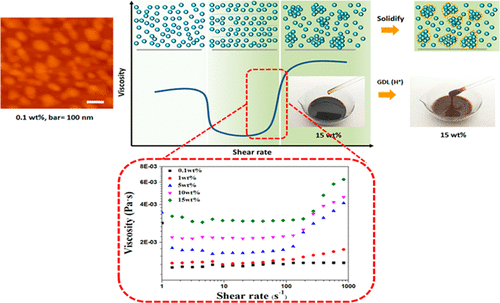当前位置:
X-MOL 学术
›
J. Agric. Food Chem.
›
论文详情
Our official English website, www.x-mol.net, welcomes your feedback! (Note: you will need to create a separate account there.)
Unexpected Rheological Behavior of a Hydrophobic Associative Shellac-Based Oligomeric Food Thickener
Journal of Agricultural and Food Chemistry ( IF 6.1 ) Pub Date : 2018-06-07 00:00:00 , DOI: 10.1021/acs.jafc.8b01148 Jianan Gao 1, 2 , Kun Li 1 , Juan Xu 1 , Wenwen Zhang 1 , Jinju Ma 1 , Lanxiang Liu 1 , Yanlin Sun 2 , Hong Zhang 1 , Kai Li 1
Journal of Agricultural and Food Chemistry ( IF 6.1 ) Pub Date : 2018-06-07 00:00:00 , DOI: 10.1021/acs.jafc.8b01148 Jianan Gao 1, 2 , Kun Li 1 , Juan Xu 1 , Wenwen Zhang 1 , Jinju Ma 1 , Lanxiang Liu 1 , Yanlin Sun 2 , Hong Zhang 1 , Kai Li 1
Affiliation

|
Sodium shellac constituted of a “surfactant” monomer, which is sensitive to shear stress, exhibits shear-thickening behavior at a low concentration (5 wt %), and reacts with H+ to retain transient high viscosity under shear, is introduced in this study. The steady shear flow test proved that, under a high shear rate, sodium shellac suspension could change from Newtonian fluid to continuous shear-thickening non-Newtonian fluid. The dynamic oscillation test suggested that the sodium shellac solution at low concentrations (0.1 and 1 wt %) under a low shear rate behaved as the viscous fluid (G″ > G′), and the solution at high concentrations (5, 10, and 15 wt %) behaved as the elastic fluid (G″ < G′). Moreover, a high shear rate caused a cross-linking point between the G″ and G′ curve. At a low concentration, it could be the sol–gel point. At a high concentration, it could be the gel–sol point. All of these transforming points were related to the interaction between the sodium clusters. This interaction should be the hydrophobic association between the particles. To prove the assumption, hydrophilic polymer poly(ethylene oxide) (PEO) was employed as the disrupting factor to the hydrophobic association. As expected, the shear-thickening behavior vanished after mixing with PEO, which verified our assumption. On the other hand, the high viscosity of the suspension under shear could be retained by reaction with H+ to solidify the transient hydroclusters under shear. Meanwhile, sodium shellac had great potential as the functional shear thickener, which could modify the rheological property of the polymer with carboxyl groups, e.g., pectin, alginate, or poly(acrylic acid). Thus, this natural and green thicker has great potential in food, medical gel, green adhesive, or cosmetic products.
中文翻译:

疏水性基于虫胶的低聚食品增稠剂的流变行为
本研究介绍了由“表面活性剂”单体构成的虫胶钠,该单体对剪切应力敏感,在低浓度(5 wt%)下表现出剪切增稠行为,并与H +反应以在剪切下保持瞬时高粘度。 。稳定的剪切流动试验证明,在高剪切速率下,虫胶酸钠悬浮液可以从牛顿流体变为连续剪切增稠的非牛顿流体。动态振动试验表明,低剪切速率下低浓度(0.1和1 wt%)的虫胶钠溶液表现为粘性流体(G ”> G),而高浓度(5、10和10)则表现为粘性流体。15 wt%)表现为弹性流体(G ''< G'')。此外,高剪切速率导致G ″和G ′曲线之间的交联点。在低浓度下,它可能是溶胶-凝胶点。在高浓度下,它可能是凝胶-溶胶点。所有这些转变点都与钠簇之间的相互作用有关。这种相互作用应该是颗粒之间的疏水缔合。为了证明这一假设,采用亲水性聚合物聚环氧乙烷(PEO)作为破坏疏水缔合的因素。正如预期的那样,在与PEO混合后,剪切增稠行为消失了,这证明了我们的假设。另一方面,悬浮液在剪切下的高粘度可通过与H +反应保持在剪切作用下固化瞬态水团簇。同时,紫胶钠作为功能性剪切增稠剂具有巨大的潜力,它可以改变带有果胶,果胶或聚丙烯酸等羧基的聚合物的流变性能。因此,这种天然和绿色的增稠剂在食品,医用凝胶,绿色粘合剂或化妆品中具有巨大的潜力。
更新日期:2018-06-07
中文翻译:

疏水性基于虫胶的低聚食品增稠剂的流变行为
本研究介绍了由“表面活性剂”单体构成的虫胶钠,该单体对剪切应力敏感,在低浓度(5 wt%)下表现出剪切增稠行为,并与H +反应以在剪切下保持瞬时高粘度。 。稳定的剪切流动试验证明,在高剪切速率下,虫胶酸钠悬浮液可以从牛顿流体变为连续剪切增稠的非牛顿流体。动态振动试验表明,低剪切速率下低浓度(0.1和1 wt%)的虫胶钠溶液表现为粘性流体(G ”> G),而高浓度(5、10和10)则表现为粘性流体。15 wt%)表现为弹性流体(G ''< G'')。此外,高剪切速率导致G ″和G ′曲线之间的交联点。在低浓度下,它可能是溶胶-凝胶点。在高浓度下,它可能是凝胶-溶胶点。所有这些转变点都与钠簇之间的相互作用有关。这种相互作用应该是颗粒之间的疏水缔合。为了证明这一假设,采用亲水性聚合物聚环氧乙烷(PEO)作为破坏疏水缔合的因素。正如预期的那样,在与PEO混合后,剪切增稠行为消失了,这证明了我们的假设。另一方面,悬浮液在剪切下的高粘度可通过与H +反应保持在剪切作用下固化瞬态水团簇。同时,紫胶钠作为功能性剪切增稠剂具有巨大的潜力,它可以改变带有果胶,果胶或聚丙烯酸等羧基的聚合物的流变性能。因此,这种天然和绿色的增稠剂在食品,医用凝胶,绿色粘合剂或化妆品中具有巨大的潜力。



























 京公网安备 11010802027423号
京公网安备 11010802027423号